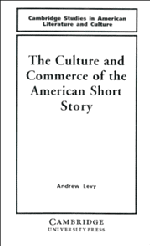Book contents
- Frontmatter
- Contents
- List of Illustrations
- Preface
- Introduction
- 1 Poe's Magazine
- 2 The Land of Definition
- 3 Edith Wharton: The Muse's Strategy
- 4 Handbooks and Workshops: A Brief History of the Creative Writing ‘Revolution’
- 5 Back Home Again: Bobbie Ann Mason's “Shiloh”
- Postscript: Iowa City
- Notes
- Index
- Titles in the series
4 - Handbooks and Workshops: A Brief History of the Creative Writing ‘Revolution’
Published online by Cambridge University Press: 23 September 2009
- Frontmatter
- Contents
- List of Illustrations
- Preface
- Introduction
- 1 Poe's Magazine
- 2 The Land of Definition
- 3 Edith Wharton: The Muse's Strategy
- 4 Handbooks and Workshops: A Brief History of the Creative Writing ‘Revolution’
- 5 Back Home Again: Bobbie Ann Mason's “Shiloh”
- Postscript: Iowa City
- Notes
- Index
- Titles in the series
Summary
When some man of a different race than ours, living in a more congenial civilization, whose training from his youth up has been adopted to a future artistic profession, succeeds in painting the great picture, composing the great prelude, writing the great novel, don't say he was born a “genius,” but rather admit that he was made “to order” by a System whose promoters knew how to wait.
Frank Norris, “Novelists to Order – While You Wait,” syndicated 23 Feb. 1903, reprinted in Pizer, ed., Literary Criticism (1964) 17.For the serious writers of the early twentieth Century, the how-to-write-a-short-story handbook constituted a literary movement of enormous and ominous potential. Sherwood Anderson complained of the “tremendous standardization of life” exemplifled in the handbook literature, and offered the “Modern Movement” as “an effort to re-open the Channels of individual expression.” James T. Farrell wrote of a “cabalistic lore” that “explicitly affirms and enforces an acceptance of the aims and ideals that are part of the ideological structure of capitalism.” Cleanth Brooks and Robert Penn Warren devoted their Understanding Fiction (1943) to the premise that “if one learns anything about fiction … it is that there is no single, Special technique or formula for writing good fiction.” Edward J. O'Brien, first editor of the Best American Short Stories, stated that “you cannot turn out short stories by mass production like Ford cars.” And Douglas Bement, a handbook author himself, wrote in 1931 of “the twentieth-century writing hysteria,” a phenomenon he believed would attract the attention of “scholars of the twenty-first Century.”
- Type
- Chapter
- Information
- The Culture and Commerce of the American Short Story , pp. 77 - 107Publisher: Cambridge University PressPrint publication year: 1993



